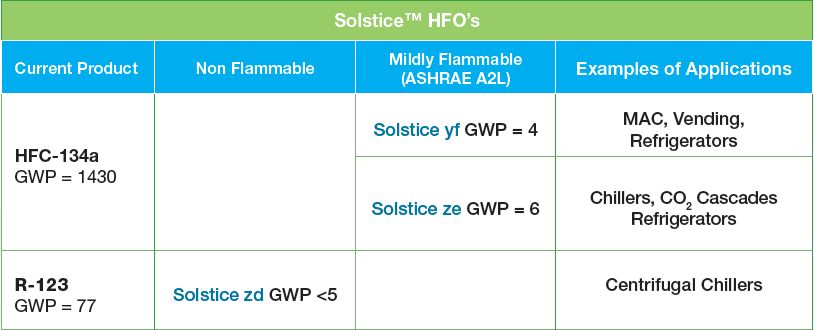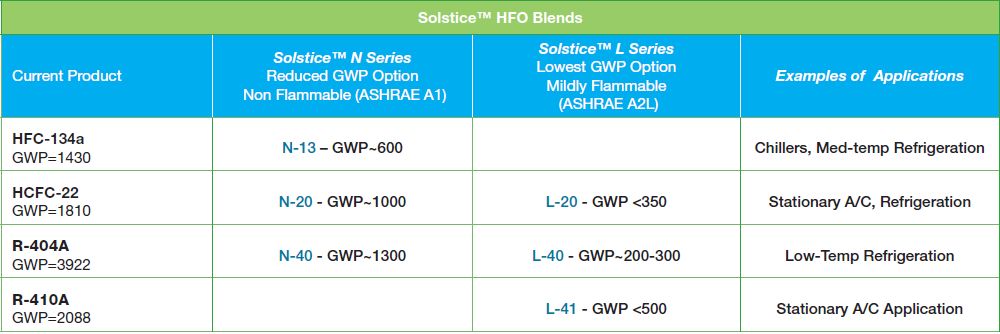Mr Achaichia, our clients are wondering about the future of refrigerants and how they are used. Today, there are new products on the air conditioning and refrigeration market, and frequent, often contradictory debates keep them from getting a clear view of what’s to come.
Between hydrocarbons, so-called natural fluids, HFOs and other substitutes, can you give us a status update and tell us about the solutions of the future?
N. A. : The development of so-called synthetic refrigerants became possible because so-called natural refrigerants were dangerous, ineffective, and expensive to use. The rebirth of these so-called natural fluids is due to their low GWP. Today, the new generation of HFOs have more than just performance and safety features similar to HFCs, they also have good environmental properties characterised by low GWP. Several conditions must be met in order to choose the right refrigerant.
There is no single solution for all applications, which is why there is a large range of refrigerants to meet every need. There may be room for natural fluids, such as when using hydrocarbons in home refrigeration, where the refrigerant’s load is low and permitted by safety standards.
CO2 for example, has good qualities for low-temperature applications, and we see it used in low-temperature commercial refrigeration, especially in Nordic countries. To overcome the technical limitations of CO2 at high ambient temperatures, CO2/HFC hybrid systems been developed. This solution will also exist in the future with CO2/HFO systems to reduce the carbon footprint. For the vast majority of applications, HFO fluids will be the choice of tomorrow. At present, we already have HFO mixtures to replace most existing fluids.
More specifically, what are the main characteristics of hydrofluoroolefins (HFOs)? Why do you recommend this alternative?
N. A. : HFO (Hydrofluoro-Olefines) are a class of unsaturated molecules that contain at least one carbon-carbon double bond. These molecules are highly reactive in the atmosphere, and consequently have a relatively short lifespan. This short lifespan partially contributes to the low GWP of these new fluids.
HFOs have excellent environmental properties, which could have a favourable long-term impact on climate change and abide by current and future legisltion, owing to their low GWP and energy efficiency.
Most HFOs have service conditions similar to those of HFCs. This means that best practises developed over the years by engineers are not lost, and existing equipment can still be used with little or no modifications.
Solstice™ products from Honeywell

HFO Solstice™
Are these new molecules toxic?
N.A. : Honeywell takes safety very seriously. These new molecules are subjected to extensive toxicity tests. The purpose of the toxicity tests is to evaluate a compound’s potential hazards and determine acceptable exposure levels that will not have unfavourable, lasting, or irreversible effects on human beings and the environment.
There are industry standards that cover safety, such as ISO 5149 and the EN 378 standard. Refrigerants are divided into two toxicity classes. Class A for low toxicity refrigerants and Class B for for higher toxicity. The two main molecules HFO 1234yf and HFO 1234ze are both Class A, and mixtures containing these molecules will also be Class A.
Many questions have been raised about the flammability of these new products. What can you tell us about this?
N.A. : Since ammonia ignites between 100 and 300mJ, and the minimum ignition energy of hydrocarbons is less than 1mJ, these products are classified as flammable.
For the first two HFO molecules available, the flammability characteristics have been measured. It has been found that HFO-1234ze(E) is entirely non-flammable at ambient temperatures below 30C.
The minimum ignition energy of HFO-1234yf is between 5000 and 10000mJ, which is much higher than for R-32, which ignites between 30 and 100mJ. As a result, the safety classification of refrigerants in accordance with the ASHRAE 34 standard and the ISO 817 standard has been modified to take into account the low flammability of the new fluids. A new class 2L was therefore created, for fluids with low flammability and a rate of burn below 10cm/s.
This is true of HFO 1234yf, which with a very unstable flame burning at 1.5 cm/s was approved by the automobile industry to replace R-134a..
Will installers need to change existing systems to use these new molecules?
N.A. : Unlike CO2, HFOs have been developed to match the current characteristics of HFC refrigerants. We have identified alternatives for each HFC fluid. They can be used is existing equipment with little or no modification.
Will investment be high to convert HFC installations over to HFO fluids?
N.A. : As I said, these new fluids were designed to be used in existing installations with little or no modification. This implies a minimal investment cost.
In concrete terms, what molecules are currently available, and for which refrigeration and air conditioning applications?
N.A. : Currently, three new pure fluids and several mixtures made from these molecules are available.
SolsticeTM yf, with its characteristics similar to those of R-134a, can be used in current R-134a applications, taking into account its A2L classification. At the moment it is mainly used in automobile air-conditioning. Solstice™ ze is another HFO to replace R-134a, with lower instant capacity but better efficiency. Many chillers have adopted this new HFO SolsticeTM ze. Even the Turbocor compressor has been approved to work with this fluid.
When will HFOs be available on the market for other applications?
N. A. : Solstice™ yf and Solstice™ ze are available. Solstice™ yf is available in limited quantities for the automobile industry, unlike SolsticeTM ze which is available without restrictions. The various HFO-based mixtures are in development, but are already available for partners who wish to conduct tests. We are now in the process of evaluating these mixtures with multiple OEMs, both for refrigeration and air-conditioning applications. These mixtures will be available in 2013.
Finally, what feedback has been received from using these new molecules?
N.A. : The feedback from Solstice™ ze used in chillers has been very positive. This is because measurements have shown a better COP compared to R-134a. Multiple compressor technologies have been approved with this fluid. The Turbocar centrifuge from Danfoss is also available for these applications. The trend is clear: future chillers will be loaded with 1234ze.

Mélange HFO Solstice™ pour utilisation à moyenne ou haute pression

